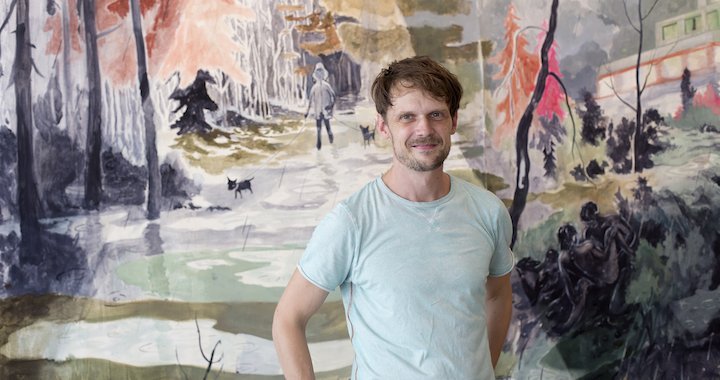
“Stress is the Opposite of Art”
An interview with German painter Tilo Baumgärtel
20/08/2014
Photo: Kristīne Madjare
Tilo Baumgärtel GOGO is on view at the “Māksla XO” gallery in Riga through September 2
“The hottest place on Earth” is how Joachim Pissarro, art historian and curator at MoMA, described the art scene in Leipzig in an article in The New York Times in 2006. American art collectors were swarming the studios in the former East German city like bees around a pot of honey, and they were ready to buy anything and everything that had been painted in Leipzig. One of these five fledgling artists in their thirties that made up the so-called New Leipzig School was Tilo Baumgärtel (1972). His show GOGO, at the “Māksla XO” gallery, is a rather notable happening in the Riga art scene, for Baumgärtel's paintings have gained quite a global reputation since the 2006 boom.
Neo Rauch, born a decade earlier than the above-mentioned “Leipzig five”, also belongs to the New Leipzig School, and is currently represented by New York's prestigious David Zwirner gallery. Rauch and Baumgärtel shared a studio in 1990s Leipzig and, through their development of a form of narrative painting that consisted of a blend of social-realism, pop art and comics, served as inspiration for one another back then. Gerd Harry Lybke, Leipzig's first gallery owner (and for many years, a nude model for Rauch), played a large part in making Rauch internationally renown; as soon as the Berlin Wall fell, Lybke opened a branch gallery in Berlin and borrowed money to start dealing on the global market. Just last year, the EIGEN+ART gallery's Leipzig branch celebrated its 30-year anniversary. During the Leipzig boom in 2006, Art Review's list of the 100 most powerful figures in the contemporary art world had Rauch in 66th place, and Lybke in 67th. Collectors became increasingly interested in the art coming from Leipzig, and the cat was let out of the bag. Almost ten years have passed since the Leipzig School reached its zenith. Most of the artists have attained stable international careers, a following of interested collectors, and several dealers; Baumgärtel is represented by the Wilkinson Gallery in London, by Christian Ehrentraut in Berlin, and by Adam Biesk in Los Angeles.
Baumgärtel has arrived in Riga with his whole family – his wife and three kids, and cannot stop expressing his joy at the individual approach and great interest garnered by the stories hidden in his paintings and drawings. In working with European and American galleries, Baumgärtel has become used to simply packing up and sending off his artworks. With a glass of ice-cold white wine in hand, Baumgärtel sits down among the clamor of the exhibition being set up, and unassumingly explains that the wine will help him with his English.
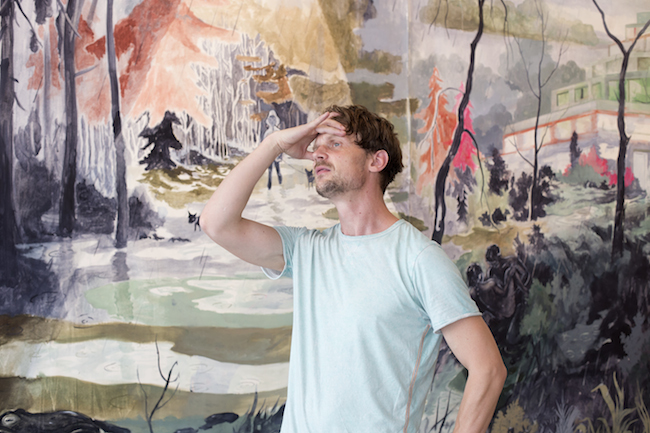
Have you been to Latvia before?
Yes, six years ago. A German journalist friend of mine has a country house in Latvia. I also visited Riga because that's where he works.
What was it that made you accept the invitation from the Māksla XO gallery to put on a solo show in Riga?
I really like the atmosphere in Riga. It's like the one that could be found in Berlin shortly after the Wall came down. A refreshing feeling that now, everything is possible. In Riga you can still find buildings that haven't been refurbished, or ones that have just begun to be restored, with modern shops that have already moved into the ground floors. I checked Google Streetview before I came, to see if the charming ambiance of the city hadn't disappeared over these six years – but everything is fine.
Your exhibition in Riga is titled “GOGO”. What's the story behind this name?
First of all, it sounds good! But I also found out that in Japanese, “gogo” means the second half of the day – from noon to midnight. That's the time when I am most productive and when I create the greater part of my drawings and paintings. Of course, there's also the play on words with the term “gogo dancer”; this could also work because they only dance during the second half of the day.
How did you select which pieces to show?
They're mostly new works, scattered with a few older ones. I also took into consideration that you have the sea here, and that it's summertime.
The gallery's second room is devoted to your drawings. Were they made as final works in themselves, or were they sketches for paintings?
Usually the drawings are final works, but sometimes I do feel that I'd like to enlarge them so that I can work out the details, and then I transfer them into paintings.
Do you always make a sketch before you start painting?
Most of the time, yes. I really like to sketch. I've published a book of the best sketches from fifteen of my large sketchbooks [Skizzen 2002–2008, publishers: Lubok Verlag, 2009 – A.I.]. A sketch is like the “small talk” that precedes a drawing. But sometimes, this small talk sticks in the memory as something special. It's the same way with sketches.
Most artists keep their sketches behind the scenes – as a too intimate and unfinished part of the working process.
I have no secrets. In addition, I can hang several of the sketches on the wall as great drawings in themselves.
Some of the large paintings have almost identical ones next to them, just smaller in size.
Yes, those are the doll-house versions of the paintings (laughs).
Which one comes first – the small one?
It varies; sometimes both are made at once. For instance, so that I have something that I can take home and try out some motifs on with a bold hand. Sometimes it serves as a model for the large painting.
The painter Neo Rauch has said that painting gives him the opportunity to continue dreaming. Could you say the same thing? The presence of dreams and the surreal – as a slight offset from reality – is very characteristic of your work.
I tend to have very interesting dreams – usually at the time between eight and ten in the morning. But usually I can't use them in my paintings even if I wanted to, because dreams are too multi-medial and overly rich in narrative; the only way they could be embodied would be through film. What I am able to do, though, is borrow the atmosphere of dreams, but with a completely different plot and characters.
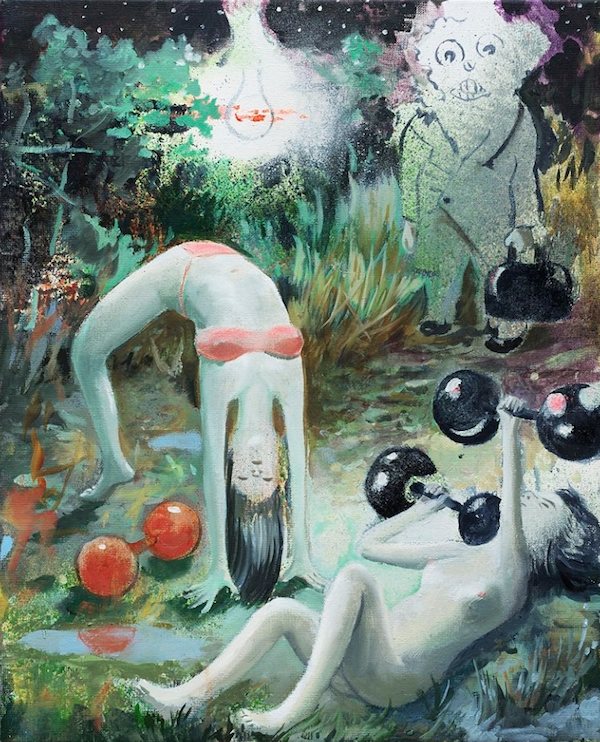
How do the stories in your paintings come to be?
I go to the studio, sit down at the table and start drawing. I give myself over to drawing, without any rational thought. And at that moment, perhaps, the material for the next painting is created. Sometimes an idea forms while I'm waiting at a red light, and I try to sketch it out that evening. I think that's what it's like for any artist. If you try to deliberately think up something special, make something interesting – it won't work. The ideas for paintings come about from a string of small chance happenings.
But why is this presence of the surreal important to you? In writing about your work, one critic deemed it as “holes in logic”. Would it be boring for you to paint something completely realistic?
Not at all. I can see myself painting portraits. In this drawing here, you see a completely normal situation – two people working en plein air: the daughter is painting, the father watches.
But there are dark storm clouds approaching, and it doesn't seem as if they're worried about them...
Well, yes, the situation may be strange – even slightly scary.
Almost all of your works are slightly scary. Just like in fairy tales, in which there is always a sense of drama.
Perhaps I have misinterpreted my older works, but it turns out that I try to make each new work even more dramatic – because it seems to me that I'm still lacking in that. When a painting is almost finished, I still try to work on achieving as unstable an energy as possible.
In one interview, you talked about a past period in which you were asking too much of painting, and that that's why you turned to animation for a while. What is your current relationship to painting?
The relationship is tricky. I finish a painting and I really love it, but then the following day, I realize that I was mistaken – because I actually hate the painting. The work stays the same, but I'm the one that has changed, and sometimes it happens too rapidly.
Are there any of your works with which you've been satisfied over the long term?
Yes, about 30% of what I've done (laughs).
Earlier, I mentioned Neo Rauch, who is not only the most famous of the Leipzig painters, but also a good friend of yours.
Yes, we shared a studio in an old factory building in the 90s. Later on we did separate our working spaces, and the only times we'd see each other during the day was to have coffee or lunch together.
Has he had an influence on the development of your signature style?
Yes, in the 90s – definitely. Neo and I both developed narrative painting. During our conversations, we'd share information on other artists or comics we had happened upon. Together we selected and collected things that could be relevant to us. Our recipe for painting and graphic arts at the time was 1940s comics which we diluted with Andy Warhol-type pop art and ugly, evil, WWII-era German illustrations. Around the year 2000, our paths parted. When I take a look into Neo's studio now, I see that his painting style is heading towards the classical. He's inspired by late baroque compositions, and his works are impressive and extremely large. Meanwhile, I'm heading into my own illustrative style, in which narrative still has great meaning.
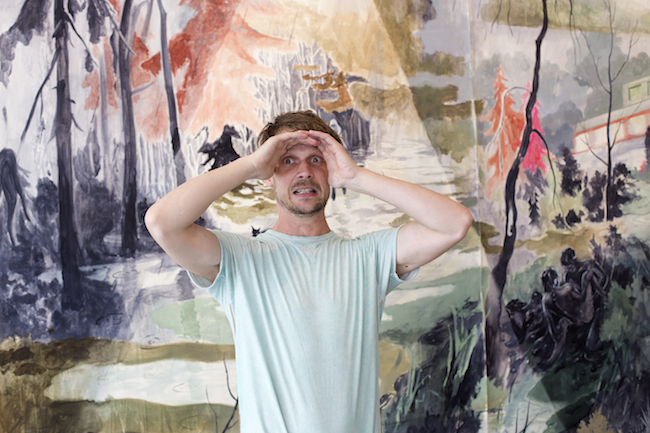
When describing the development of the Leipzig art scene, your long-time teacher, the artist Arno Rink, has said that the Wall protected you from Joseph Beuys, and that that's why there are so many figural painters.
(Laughs) Yes, that's true in a sense. I had a very poor notion of conceptual and experimental art – just informational crumbs from television programs or catalogs. Even though there were a few East German underground artists who worked similarly to Beuys. But I don't think that that's why I ended up doing figural painting. I simply think that I wouldn't be as good at anything else. I've tried my hand at installations and sculpture, but painting is the medium in which I can express my desire for playing. To portray events on the canvas in the style of Friedrich Schiller [the German poet, playwright and philosopher who said that we are the most human when we are at play; this is upon which Schiller based his aesthetic understanding – A.I.]. To play through numerous versions of reality. Most other art mediums seem unfamiliar to me. With drawing, I can be the most spontaneous. I feel like I'm a part of the communities made up by comics' illustrators and masters of narrative painting; it started in my childhood, when I began collecting the drawings of William Hogarth [an 18th-century British painter and one of the first illustrators of comics – A.I.]
Do you remember where you were when the Berlin Wall came down?
A few days after its falling, my friends and I drove to Berlin from Leipzig with motorcycles, to see it with our own eyes.

What was the atmosphere like in Leipzig at the time?
It was strange, but at the same time – euphoric, because it seemed that now things are going to start, now everything is possible! Which, of course, was misleading. Many people left their usual places of work to start building their dream-castles, to quickly take positions of leadership and so on; but few actually reached these goals because the Western world brought stiff competition along with it.
How did the young East German artists feel about all this?
The coming down of the Wall was nothing but good for artists – the borders were open, there was now the possibility of seeing Europe and the world, and there was also the possibility of making it big. That is the advantage of being an artist – even if you come from a poor family or a downtrodden corner of the world, you still have a chance at making a good career for yourself with your talent. For a slew of East German artists, the coming down of the Wall came as a breaking point – because now they could see how truly competent they were. And many really did climb the international career ladder.
How would you describe the New Leipzig School phenomenon? What were the conditions that led to this success story in which the Leipzig art scene became “the hottest spot on Earth”?
The art world is always looking for new “hot spots”. Around 2005 it was Leipzig, around 2010 it was contemporary art in China; currently everyone's interested in Romania, Slovakia, Slovenia, Poland and Russia.
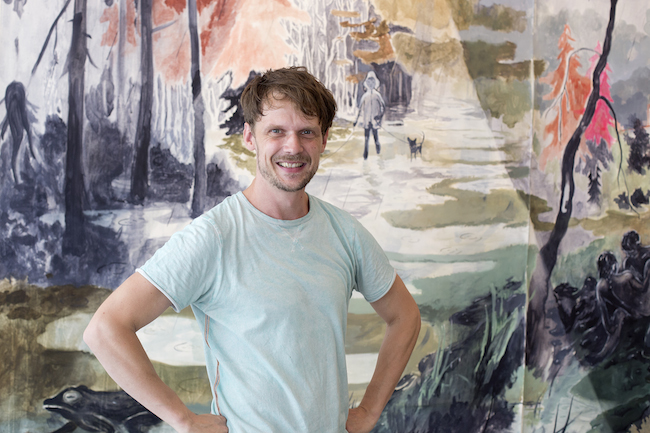
But what were the serendipitous conditions that led to the whole world suddenly talking about the art coming out of Leipzig?
Certain exhibitions and personalities were in the right place at the right time. The snowball effect started with an appearance at the Armory Show, in New York. Then Hollywood producer Michael Ovitz arrived in Germany – in Dustin Hoffman's private plane because Hoffman's daughter wanted to study art there. They were very interested in Leipzig, and they bought works by practically every artist in the city. Later on, several Leipzig artists were given solo shows in New York and Los Angeles. Michael Ovitz was a manager for a slew of Hollywood's most famous actors, and he tried to convince them to become art collectors. That's how, for example, Leonardo DiCaprio and Brad Pitt were turned onto art.
You were around 30 years old at the time. Weren't you euphoric to reach such a zenith of fame while still so young?
Yes, it happened too early for me. There was a period when it was too much. I had a family with very young children, and that's what made me different from my peers who were facing their success on their own. I had to strictly allocate how much time I would spend working in the studio, how much time I would need to prepare my next solo show, and how much time I could devote to my family. At times, there was so much stress that I even considered taking myself out of the game – jumping off of the wave. I had also noticed that the artists that had begun to practically manufacture their works were, over time, dulling their talent and lessening their quality. Stress is the opposite of art.
Many artists wish to break out and be successful and have a good career, but at the same time, their chosen field – art – is about something else entirely, it's about timelessness and freedom from mercantile interests. How can these opposites come together?
One must remember that there are different artistic types. There are those for whom success or an audience are of little importance, and for whom art is like a form of therapy that keeps them from losing their minds. Every artist should work just for themselves at least in some sort of capacity. The next step is to think about how to set up your life so that you can work without any unnecessary stress and worries about making a living. Perhaps, for some, this means setting aside time for another job on the side. Philip Glass used to drive a taxi, and he composed several of his works while at the wheel. In any case, being a good artist and making lots of money are usually two mutually exclusive things.

How would you describe the art scene in Leipzig today, now that the above-mentioned fever has subsided?
The art scene is very lively in Leipzig; it's not even possible to get a chance to see everything. There are many moderately-sized museums and galleries, and also non-commercial art spaces and many private initiatives. In addition, the bar for quality art has stayed high – when compared to other Germany cities. Leipzig is also a good place to live and work in – the cost of living is not too high, and a spacious studio is affordable. The only downside is a lack of local art collectors, which means that international circulation must be actively organized – Leipzig's museums don't have such large budgets that they can afford to regularly purchase the works of emerging artists.
If we let our imaginations run wild for a bit – do you think that the Leipzig phenomenon could repeat itself in other post-socialistic cities, such as in Riga?
I think that it's very hard to manufacture a situation. The best method is to simply try to show yourself anywhere you can. For instance, by opening a small Latvian art kiosk in London, where the shows would regularly change and be constantly surprising the public. Yes, why not?
You've grown up, studied in, and still work in Leipzig. Have you ever thought about moving to New York, London or some other cultural metropolis?
I have, of course, thought about it. But I've only managed to live for a short while in Italy and Berlin. Last year I was given the opportunity to spend six months in New York. The offer came from a collector who owns studios in Manhattan in which I could work and live for several months at a time. But it looks like I could take up his offer only next year, at the earliest, because my oldest children are in school, and six months is a long time to be away.
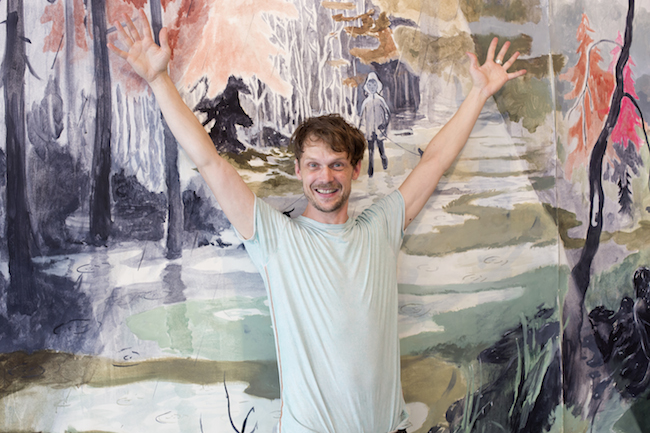
What do your children say about your works? Do they ask questions, do you discuss the works?
Not exactly. But we do draw together a lot. I draw all sorts of funny faces, or I teach them how to draw a horse. I like times like that – when there is nothing specific that has to be done and I can simply play around.
If you had the chance to start again, would you still choose to be an artist?
There are a slew of professions that I maybe considered once, and that I still believe would be exciting. For instance, biology. That which I currently give over to art, I could just as well give over to nature.
“Māksla XO” gallery
Elizabetes street 14
Riga, Latvia
www.makslaxogalerija.lv